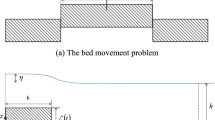Abstract
This paper presents a two-dimensional (2D)–three-dimensional (3D) hybrid stabilized finite element method that enables us to predict a propagation process of tsunami generated in a hypocentral region, which ranges from offshore propagation to runup to urban areas, with high accuracy and relatively low computational costs. To be more specific, the 2D shallow water equation is employed to simulate the propagation of offshore waves, while the 3D Navier–Stokes equation is employed for the runup in urban areas. The stabilized finite element method is utilized for numerical simulations for both of the 2D and 3D domains that are independently discretized with unstructured meshes. The multi-point constraint and transmission methods are applied to satisfy the continuity of flow velocities and pressures at the interface between the resulting 2D and 3D meshes, since neither their spatial dimensions nor node arrangements are consistent. Numerical examples are presented to demonstrate the performance of the proposed hybrid method to simulate tsunami behavior, including offshore propagation and runup to urban areas, with substantially lower computation costs in comparison with full 3D computations.





















Similar content being viewed by others
References
Kashiyama K, Saitoh K, Behr M, Tezduyar TE (1997) Parallel finite element methods for large-scale computation of storm surges and tidal flows. Int J Numer Methods in Fluids 24:1371–1389
Heniche M, Secretan Y, Boudreau P, Leclerc M (2000) A two-dimensional finite element drying-wetting shallow water model for rivers and estuaries. Adv Water Resour 23:360–371
Bunya S, Kubotko EJ, Westerink JJ, Dawson C (2009) Wetting and drying treatment for the Runge-Kutta discontinuous Galerkin solution to the shallow water equations. Comput Methods Appl Mech Eng 198:1548–1562
Takase S, Kashiyama K, Tanaka S, Tezduyar TE (2011) Space-time SUPG finite element computation of shallow-water flows with moving shorelines. Comput Mech 48:293–306
Yamazaki Y, Cheung KF, Kowalik Z (2011) Depth-integrated, non-hydrostatic model with grid nesting for tsunami generation, propagation, and run-up. Int J Numer Methods Fluids 67:2081–2107
Guan M, Wright NG, Sleigh PA (2013) A robust 2D shallow water model for solving flow over complex topography using homogenous flux method. Int J Numer Methods Fluids 73:225–249
Aliabadi S, Abedi J, Zellars B, Bota K, Johnson A (2003) Simulation technique for wave generation. Commun Numer Methods Eng 19:349–359
Masamura K, Fujima K, Goto C, Lida K (2000) Numerical analysis of tsunami by using 2D/3D hybrid model. J. JSCE II 54:49–61 (in Japanese)
Masamura K, Fujima K, Goto Shigemura T (2001) Examinations of fluid forces on the structure by using 2D/3D hybrid model. Proc Hydraul Eng JSCE 45:1243–1248 (in Japanese)
Fujima K, Masamura K, Goto C (2002) Development of the 2D/3D hybrid model for tsunami numerical simulation. Coast Eng J 44(4):373–397
Pringle W, Yoneyama N (2013) The application of a hybrid 2D/3D numerical tsunami inundation-propagation flow model to the 2011 off the pacific coast of Tohoku earthquake tsunami. J JSCE Ser B2 (Coastal Engineering) 69(2):I\_306–I\_310 (in Japanese)
Liu GR, Quek SS (2003) The finite element method : a practical course. Butterworth-Heinemann, Oxford
Brooks AN, Hughes TJR (1982) Streamline-upwind/Petrov-Galerkin formulations for convection dominated flows with particular emphasis on the incompressible Navier-Stokes equations. Comput Methods Appl Mech Eng 32:199–259
Tezduyar TE (1991) Stabilized finite element formulations for incompressible flow computations. Adv Appl Mech 28:1–44
Aliabadi S, Tezduyar TE (2000) Stabilized-finite-element/interface-caputuring technique for parallel computation of unsteady flows with interfaces. Comput Methods Appl Mech Eng 190:243–261
Bova SW, Carey GF (1996) A symmetric formulation and SUPG scheme for the shallow-water equations. Adv Water Resour 19(3):123–131
Matsumoto J, Umetsu T, Kawahara M (2003) Stabilized bubble function method for shallow water long wave equation. Int J Comp Fluid Dyn 17:319–325
Sakuraba M, Kashiyama K (2003) Free surface flow using levelset method based on stablized finite element method. Proc Coast Eng JSCE 50:16–22 (in Japanese)
Acknowledgments
This study is conducted with support from the Grants-in-Aid for Scientific Research (A) (Research Project No.: 25246043) “Multi-scale Numerical Experiments for Evaluation of Interaction between Runup Tsunami and Structures”. We are grateful for the support.
Author information
Authors and Affiliations
Corresponding author
Rights and permissions
About this article
Cite this article
Takase, S., Moriguchi, S., Terada, K. et al. 2D–3D hybrid stabilized finite element method for tsunami runup simulations. Comput Mech 58, 411–422 (2016). https://doi.org/10.1007/s00466-016-1300-4
Received:
Accepted:
Published:
Issue Date:
DOI: https://doi.org/10.1007/s00466-016-1300-4




